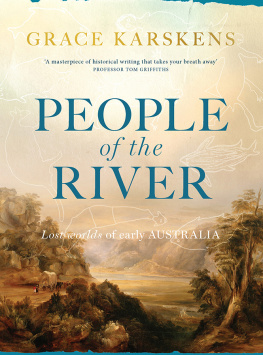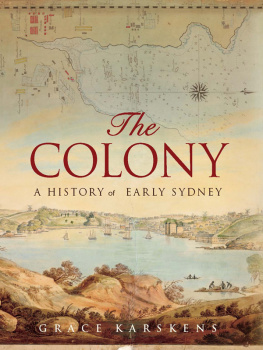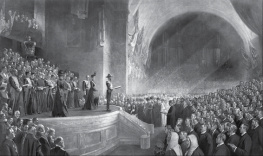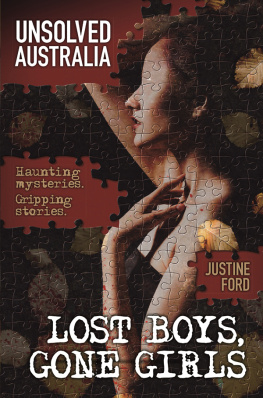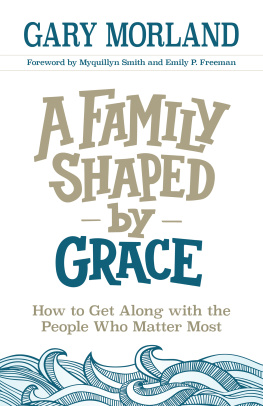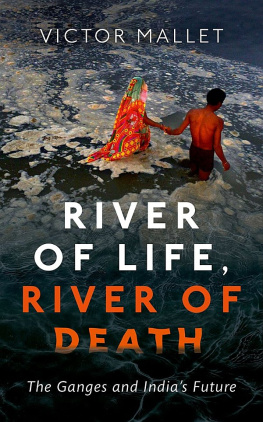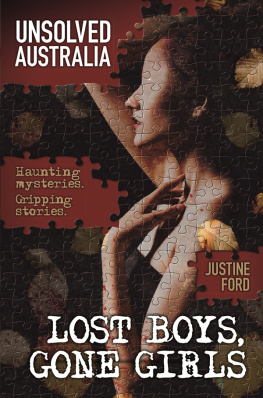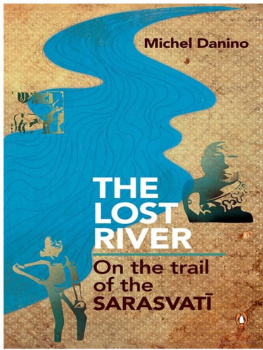Grace Karskens - People of the River: Lost worlds of early Australia
Here you can read online Grace Karskens - People of the River: Lost worlds of early Australia full text of the book (entire story) in english for free. Download pdf and epub, get meaning, cover and reviews about this ebook. year: 2020, publisher: Allen & Unwin, genre: Politics. Description of the work, (preface) as well as reviews are available. Best literature library LitArk.com created for fans of good reading and offers a wide selection of genres:
Romance novel
Science fiction
Adventure
Detective
Science
History
Home and family
Prose
Art
Politics
Computer
Non-fiction
Religion
Business
Children
Humor
Choose a favorite category and find really read worthwhile books. Enjoy immersion in the world of imagination, feel the emotions of the characters or learn something new for yourself, make an fascinating discovery.
- Book:People of the River: Lost worlds of early Australia
- Author:
- Publisher:Allen & Unwin
- Genre:
- Year:2020
- Rating:4 / 5
- Favourites:Add to favourites
- Your mark:
- 80
- 1
- 2
- 3
- 4
- 5
People of the River: Lost worlds of early Australia: summary, description and annotation
We offer to read an annotation, description, summary or preface (depends on what the author of the book "People of the River: Lost worlds of early Australia" wrote himself). If you haven't found the necessary information about the book — write in the comments, we will try to find it.
People of the River: Lost worlds of early Australia — read online for free the complete book (whole text) full work
Below is the text of the book, divided by pages. System saving the place of the last page read, allows you to conveniently read the book "People of the River: Lost worlds of early Australia" online for free, without having to search again every time where you left off. Put a bookmark, and you can go to the page where you finished reading at any time.
Font size:
Interval:
Bookmark:

This is a masterpiece of historical writing that takes your breath away. Grace Karskens has an unparalleled command of colonial Australian history and one feels she knows almost everything its possible to know about her people and their river. The story glows with warmth and sparkles with spirit and vitality. I dont think we have anything quite like this in Australian literature: a compassionate, intimate portrait of people, black and white, in a beloved, dynamic landscape.
PROFESSOR TOM GRIFFITHS, AUTHOR OF THE ART OF TIME TRAVEL
A majestic book. The story of a river, not just its flowing waters, but the ebb and flow of people, both black and white, upon its historical course.
PROFESSOR JOHN MAYNARD, UNIVERSITY OF NEWCASTLE
With shimmering prose Grace Karskens shows us that this is a river pulsing with stories, right down to the pebbles and stones. She digs forensically deep to resuscitate characters, histories and language long thought gone, from the rivers birth to the ongoing Aboriginal connection to the river today.
ASSOCIATE PROFESSOR TIFFANY SHELLAM, AUTHOR OF MEETING THE WAYLO
First published in 2020
Copyright Grace Karskens 2020
All rights reserved. No part of this book may be reproduced or transmitted in any form or by any means, electronic or mechanical, including photocopying, recording or by any information storage and retrieval system, without prior permission in writing from the publisher. The Australian Copyright Act 1968 (the Act) allows a maximum of one chapter or 10 per cent of this book, whichever is the greater, to be photocopied by any educational institution for its educational purposes provided that the educational institution (or body that administers it) has given a remuneration notice to the Copyright Agency (Australia) under the Act.
Allen & Unwin
83 Alexander Street
Crows Nest NSW 2065
Australia
Phone:(61 2) 8425 0100
Email:
Web:www.allenandunwin.com

ISBN 978 1 76029 223 2
eISBN 978 1 95253 559 8
Maps on pages viiix by Paul Irish
Index by Garry Cousins
Set by Midland Typesetters, Australia
For Iannis,
Ophelia Grace and
Francine
with love


Dhuurlaan: major river
Maarang: river
Dhurlang, dhurtang, dyurlang: minor river or creek
Warlukwarluk: crooked river
Dhugaluu: river dropping into a deep hole
Gurradula: junction of rivers
Guungung: river in flood
Jim Barrett, Gandanguurra: The language of the mountain peopleand beyond
Sometime in the summer of 17934, a small group of peoplemen, women and childrenappeared on Dyarubbin, the river. They made for Dowlaba, in the crook of the tributary stream Wianamatta, where the huge, broad-barrelled eucalypts stood far apart, and the dense, viny undergrowth covering most of the rivers banks opened out clear and grassy. They cut bark and timber for shelters with their axes, lit fires against the darkness, and feasted on the ducks and other wild birds they had caught in the vast lagoons nearby.
Soon, at various spots along the reach between Wianamatta and Werriling, the next river bend downstream, the strangers began breaking up the rich river soils with their hoes, uprooting yams and grasses. They scattered ears of corn and wheat seeds, dropped potatoes and peach stones. These strange plants flourished magnificently, and soon the news was out. More and more of these people arrived, some with guns, many with wuragal, large, savage hunting dogs, and darramuwa, pigs, dangerous but tasty. Now they began to move into dugga dugga, the thickly forested parts, setting fire to the bush, hacking the flowering vines and shrubs, cutting the
Who were these people, these newcomers? And who were the people watching and listening to them, first with curiosity, then alarm and finally fury? These seem like simple questions, but they are not. The settlers who took the land on the river during the mid-1790s were there because of an extraordinary social and penal experiment devised half a world away in England. We think we know themyet these people dont fit our familiar images and ideas about settlers. The Aboriginal people who endured this invasion were there because of an even more extraordinary event in global human history: the arrival of their ancestors in Australia more than 65,000 years ago, and their successful expansion across the entire continent. But generalised understandings of Aboriginal people and culture cannot tell us who these people were. Dyarubbins people have their own history, culture and mythology, inseparable from their river Country.
Dyarubbin has one of the longest-known human histories in Australia. Aboriginal people have lived there for at least 50,000 years, their ancestors arriving well before the last Ice Age. They may have followed its winding course up from the coast, or walked down into the valley from the Blue Mountains to the west. Their history over those aeons was not timeless. It was astonishingly dynamic, marked by changing traditions and shifting alliances, and shaped by dramatic fluctuations in climate, ecology and geography.
Then, a mere two centuries ago, along came that new group of people, part of the larger reconnection that historian Tom Griffiths describes as one of the greatest ecologicalas well as culturalencounters of all time.
None of this was uncontested. The first sustained frontier wars, a series of fierce and brutal clashes, erupted three times on the river between 1794 and 1816. The HawkesburyNepean was the seedbed for settler expansion and invasion of Aboriginal lands to the north, south and west. It was the crucible of the colony and the nation that followed.
So Dyarubbin, the HawkesburyNepean, is where the two Australiasancient and modernfirst collided and were forever transformed. This book journeys into the lost worlds of both the Aboriginal people and the settlers of Dyarubbin, complex worlds with ancient roots, intersecting, crisscrossed, cut through and connected by race, gender, class and culture, by loyalties and hostilities emerging and shifting over time. Dyarubbin ran through both of these worlds, these two early Australias, flowing on from Gondwana to the present and the time to come. By following the river, and paying close attention to its history and geography, the deep past and the present may be reconnected, and seen in one anothers light.
Dyarubbin, the HawkesburyNepean River, has the deepest history of all, running vast and wild when Australia was still part of the supercontinent Gondwana more than 90 million years ago. Today, the river flows through the heart of a vast arc of sandstone country encircling Sydney and the Cumberland Plain on the east coast of Australia. Springing from a web of small creeks near the town of Robertson high in the Southern Highlands, Dyarubbin pours down through deep, stony gorges to the base of the Blue Mountains around Mulgoa, rushing deafeningly over weirs and cobbled rapids and then meandering broadly through the flat, green floodplains. Further north, around Dorumbolooa, Sackville, the river does something remarkable: it flows
Next pageFont size:
Interval:
Bookmark:
Similar books «People of the River: Lost worlds of early Australia»
Look at similar books to People of the River: Lost worlds of early Australia. We have selected literature similar in name and meaning in the hope of providing readers with more options to find new, interesting, not yet read works.
Discussion, reviews of the book People of the River: Lost worlds of early Australia and just readers' own opinions. Leave your comments, write what you think about the work, its meaning or the main characters. Specify what exactly you liked and what you didn't like, and why you think so.

